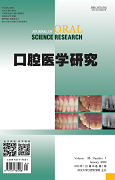|
|
Effects of Resveratrol on Proliferation and Differentiation of Osteoblasts Induced by High Glucose through SIRT1/FOXO1 Pathway
TANG Xiaoyue, ZHU Hao, CAO Can
2020, 36(1):
79-84.
DOI: 10.13701/j.cnki.kqyxyj.2020.01.019
Objective: To investigate the effects of resveratrol (Res) on the proliferation and differentiation of osteoblasts induced by high glucose and on the silence information regulator (SIRT1)/fork transcription factor (FOXO1) pathway. Methods: Rat mandibular cells were isolated and cultured, and the experiment was divided into control group, high-glucose group, high-glucose + low-dose Res group, high-glucose + medium-dose Res group, and high-glucose + high-dose Res group. CKK-8 assay was used to detect cell proliferation, ALP activity was determined by alkaline phosphatase (ALP) staining, Alizarin red S staining was used to detect the formation of calcified nodules and, Western blotting was used to detect the expressions of type I collagen (COLI) and RUNX2, osteopontin (OPN), osteocalcin (OCN), and SIRT1/FOXO1 pathway protein. Results: Compared with control group, inhibition in high-glucose group increased significantly, ALP activity, calcium nodule deposition, COLI, RUNX2, OPN, and OCN protein levels in high-glucose group decreased significantly (P<0.05). Compared with the high-glucose group, the OD value, ALP activity, calcium nodule deposition, COLI, RUNX2, OPN, and OCN protein levels of osteoblasts in resve- ratrol supplemented groups increased significantly (P<0.05), and increased with the increase of concentration. Compared with control group, the levels of SIRT1 and P27 protein of osteoblasts in high-glucose group decreased significantly, while the levels of FOXO1 and Bim increased significantly (P<0.05). Compared with the high-glucose group, the levels of SIRT1 and P27 protein increased significantly and FOXO1 and Bim protein decreased significantly after adding resveratrol (P<0.05). Conclusion: Resveratrol may improve the inhibitory effect of high glucose on osteoblasts proliferation and differentiation by adjusting SIRT1/FOXO1 pathway.
References |
Related Articles |
Metrics
|

